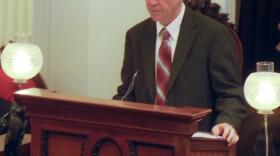Could a former major league pitcher and third-party candidate for Vermont governor force the Legislature to choose the state’s next governor? Today’s race between the Republican and Democrat is so close that some wonder if either can obtain the required 50 percent for a clear win.
The race for governor between Republican Lieutenant Governor Phil Scott and former Transportation Secretary Democrat Sue Minter is expected to be very close. The Vermont Constitution mandates that if no candidate for governor gets more than 50 percent the Legislature decides the final outcome. In fact, it happened just two years ago.
One complication among many, according to University of Vermont Political Scientist Garrison Nelson, is how many votes Liberty Union candidate Bill “Spaceman” Lee will get. “The wildcard is Bill Lee, the former Red Sox pitcher, who could deny the winner a clear victory. Putting that aside Sue Minter needs, this is her first statewide run and a number of people in their first statewide runs for governor have lost. But the big help she's getting of course is from Bernie Sanders. And Phil Scott he’s a Republican. Lieutenant governor's running for governor have not been very successful. The last wanted to do it was in 1958. In terms of his sort of likeability he's high up there. We do run the risk of this ending up in the legislature.”
Middlebury College Professor Emeritus of Political Science Eric Davis believes both the Democrat and Republican have plausible, but not necessarily clear, paths to victory. “It depends how much of the vote goes to Bill Lee, a third party candidate as well as some other independents on the ballot. But both Sue Minter and Phil Scott have said in interviews this fall that if they finish second but the first place finisher is below fifty percent of the vote they will concede and urge the legislature to vote for the first place finisher. So whoever comes in second is not going to be contesting the race in the legislature.”
Both professors say the key to deciding the race is in the state’s most populous area – Chittenden County. Nelson says it’s crucial for Democrat Minter. “Watch Burlington. If she carries Burlington big then she should win the election. She will carry it. The question is how big does she carry it by? Will be enough to kind of outweigh votes in the more rural parts of the state, the historically more Republican parts of the state.”
Eric Davis: “Areas of the state that I’ll look at is how large a margin Sue Minter can run up in the strongly Democratic parts of the state: Burlington, Winooski, Montpelier, Windham County to mention a few. How large a margin Phil Scott runs up in some of the core Republican areas of the state particularly northern Vermont and Rutland County. I think the most competitive areas in the state are going to be the Chittenden County suburbs: places like Colchester, Williston, Essex and South Burlington. And Bennington County.”
The Vermont Legislature decided the 2014 gubernatorial election between Democrat Peter Shumlin and Republican Scott Milne. Milne, who lost by just over 2,400 votes, did not concede, so the Legislature re-elected Shumlin on a vote of 110 to 69. Shumlin is not seeking a fourth term.










